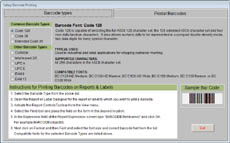Printing Bar Codes with PastPerfect Software for Museums
 Many museums are organized along the different types of collections that they hold, including some type of number system, but with PastPerfect museum software, they can now print bar codes for each item in a collection. Regardless of what is in the collection – ancient pottery, modern paintings, or dinosaur bones – each piece can have its own bar code manufactured in PastPerfect software containing every piece of information pertaining to the item in it. For those who have worked in a museum and have used PastPerfect to create and maintain records for collections in an organized database, it seems logical that a bar code can also be generated and placed on an item. Since museums have special needs when it comes to labeling items in a collection - using materials that are safe and will help preserve an item instead of further its deterioration – PastPerfect bar codes can be printed on acid-free paper, fabric, or polypropylene which are safe to use for archiving purposes. Best of all, a bar code label can be made for both a collection item record, plus the actual item itself. In the event one or the other gets lost, another copy can easily be printed out.
Many museums are organized along the different types of collections that they hold, including some type of number system, but with PastPerfect museum software, they can now print bar codes for each item in a collection. Regardless of what is in the collection – ancient pottery, modern paintings, or dinosaur bones – each piece can have its own bar code manufactured in PastPerfect software containing every piece of information pertaining to the item in it. For those who have worked in a museum and have used PastPerfect to create and maintain records for collections in an organized database, it seems logical that a bar code can also be generated and placed on an item. Since museums have special needs when it comes to labeling items in a collection - using materials that are safe and will help preserve an item instead of further its deterioration – PastPerfect bar codes can be printed on acid-free paper, fabric, or polypropylene which are safe to use for archiving purposes. Best of all, a bar code label can be made for both a collection item record, plus the actual item itself. In the event one or the other gets lost, another copy can easily be printed out.
 PastPerfect supports a number of bar code formats which include Code 39 and Code 128, both of which are most commonly used in creating bar codes for museum purposes. Code 39 supports all alphanumeric characters plus seven additional characters. This bar code format tends to be larger in size compared to Code 128 which is smaller and has minimal space in between the bars. Code 128 can also encode all ASCII 128 characters. In addition to these two types of bar codes, PastPerfect also supports the Codabar, Interleaved 2/5, UPC, and UPC E formats for making bar codes for a museum collection. The bar codes created in PastPerfect can be printed on a laser printer or special fabric printer.
PastPerfect supports a number of bar code formats which include Code 39 and Code 128, both of which are most commonly used in creating bar codes for museum purposes. Code 39 supports all alphanumeric characters plus seven additional characters. This bar code format tends to be larger in size compared to Code 128 which is smaller and has minimal space in between the bars. Code 128 can also encode all ASCII 128 characters. In addition to these two types of bar codes, PastPerfect also supports the Codabar, Interleaved 2/5, UPC, and UPC E formats for making bar codes for a museum collection. The bar codes created in PastPerfect can be printed on a laser printer or special fabric printer.
Creating a bar code label in PastPerfect is easy and requires only a few steps. The software comes with bar code labels that can be used for different museum items or they can be modified to meet the museum's needs. To add a bar code to a label, access reports on the main menu and select a custom layout. Then a matching font is selected that will match the size of the code, and the bar code is ready for printing. Bar codes can be printed one at a time or in a batch in PastPerfect.
PastPerfect began in 1996 and is a major supplier of archival software to museums around the world. The company is located in Exton, Pennsylvania and offers free trial software to potential buyers. PastPerfect software can handle all aspects of museum archiving in addition to campaigns, fundraising, pledges, and donor information. Aside from museums, PastPerfect also provides other non-profit organizations that handle a large volume or archiving materials software solutions.
http://www.museumsoftware.com/barcode.shtml
Related articles:
QR Codes to Offer Rewards at Historical Monuments
How to Use Barcodes to Catalog Your Collection
